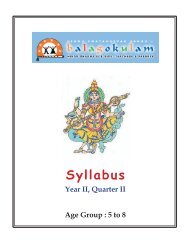Bauddhik Plan for Age Group 9-12 for the second ... - Balagokulam
Bauddhik Plan for Age Group 9-12 for the second ... - Balagokulam
Bauddhik Plan for Age Group 9-12 for the second ... - Balagokulam
You also want an ePaper? Increase the reach of your titles
YUMPU automatically turns print PDFs into web optimized ePapers that Google loves.
SeptemberDharmaAadhibhautika: The known factors around us like accidents, humancontacts, pollution, crime etc.Aadhyaatmika: We sincerely pray to <strong>the</strong> Lord that at least while weundertake special tasks or even in our daily lives, <strong>the</strong>re are no problems orthat, problems are minimized from <strong>the</strong> three sources written about above.May peace alone prevail. Hence shaanti is chanted thrice.Why do we do aarati?Towards <strong>the</strong> end of every ritualistic worship (pooja or bhajan) of <strong>the</strong> Lordor to welcome an honored guest or saint, we per<strong>for</strong>m <strong>the</strong> aarati. This is alwaysaccompanied by <strong>the</strong> ringing of <strong>the</strong> bell and sometimes by singing, playing ofmusical instruments and clapping. It is one of <strong>the</strong> sixteen steps (shodashaupachaara) of <strong>the</strong> pooja ritual. It is referred to as <strong>the</strong> lighted lamp in <strong>the</strong> righthand, which we wave in a clockwise circling movement to light <strong>the</strong> entire <strong>for</strong>mof <strong>the</strong> Lord. Each part is revealed individually and also <strong>the</strong> entire <strong>for</strong>m of <strong>the</strong>Lord. As <strong>the</strong> light is waved we ei<strong>the</strong>r do mental or loud chanting of prayers orsimply behold <strong>the</strong> beautiful <strong>for</strong>m of <strong>the</strong> Lord, illumined by <strong>the</strong> lamp. At <strong>the</strong>end of <strong>the</strong> aarati we place our hands over <strong>the</strong> flame and <strong>the</strong>n gently touch oureyes and <strong>the</strong> top of <strong>the</strong> head.We have seen and participated in this ritual from our childhood. Let usfind out why we do <strong>the</strong> aarati?Having worshipped <strong>the</strong> Lord of love - per<strong>for</strong>ming abhisheka, decorating<strong>the</strong> image and offering fruits and delicacies, we see <strong>the</strong> beauty of <strong>the</strong> Lordin all His glory. Our minds are focussed on each limb of <strong>the</strong> Lord as <strong>the</strong>lamp lights it up. It is akin to silent open-eyed meditation on His beauty. Thesinging, clapping, ringing of <strong>the</strong> bell etc. denote <strong>the</strong> joy and auspiciousnesswhich accompanies <strong>the</strong> vision of <strong>the</strong> Lord.Aarati is often per<strong>for</strong>med with camphor. This holds a telling spiritualsignificance. Camphor when lit, burns itself out completely without leaving atrace of it. It represents our inherent tendencies (vaasanas). When lit by <strong>the</strong>fire of knowledge which illumines <strong>the</strong> Lord (Truth), our vaasanas <strong>the</strong>reafterburn <strong>the</strong>mselves out completely, not leaving a trace of ego which creates inus a sense of individuality that keeps us separate from <strong>the</strong> Lord. Also whilecamphor burns to reveal <strong>the</strong> glory of Lord, it emits a pleasant perfume evenwhile it sacrifices itself. In our spiritual progress, even as we serve <strong>the</strong> guruand society, we should willingly sacrifice ourselves and all we have, to spread44Hindu Swayamsevak Sangh (HSS)
















